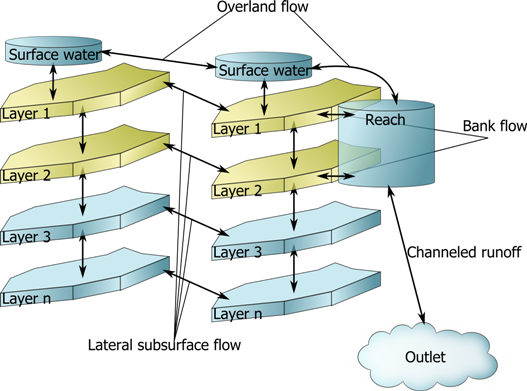|
2.0.0b10
catchment modelling framework
|
|
2.0.0b10
catchment modelling framework
|

The extension to a three dimensional landscape model essentially amounts to a process of allocating additional cells in the same fashion as for the 2D case. Topological information from existing data, where elevation grids are a very convenient starting point, is utilized to develop the lateral connections between the soil layers and the surface water automatically. From the standpoint of the framework, this procedure simply amounts to the allocation of increased number of model elements, although the complete definition of the full catchment model does require a number of addition types of water storage to effectively capture the variability and complexity of real world systems. These elements include water transport and storage by streams, dams, lakes and drainage pipe systems, the use of which is outlined in Figure 5 and code snippet 9. This is not to suggest that this type of fully-defined and physically-based catchment model is not without fault – a fact that has been the focus of a significant part of the hydrologic literature since the development of the Freeze and Harlan (1969) blueprint for the development of such a model. Going beyond discussions of parameterization and scale, the complexity of this approach, within CMF, leads to a significant demand for computational power and with standard machines, is suitable only for small catchments (less than 10 ha) at this time. One mechanism to alleviate some of these shortcomings is to invoke simplifications that are appropriate for different simulation goals.
#!python
import cmf
p=cmf.project()
r_curve=cmf.VanGenuchtenMualem()
# Load cell polygons from file
polygons=cmf.shapefile('cells.shp')
# create cell mesh from polygons
cells = cmf.cells_from_polygons(polygons, …)
# Calculate flow accumulation
p.calc_flow_acc()
for c in p.cells:
# Add ten layers
for i in range(10):
c.AddLayer((i+1)*0.1,r_curve)
cmf.Richards.use_for_cell(c)
c.surfacewater_as_storage()
# subsurface flow
cmf.connect_cells_with_flux(p,cmf.Richards_lateral)
# surface runoff
cmf.connect_cells_with_flux(p,cmf.Manning_Kinematic)